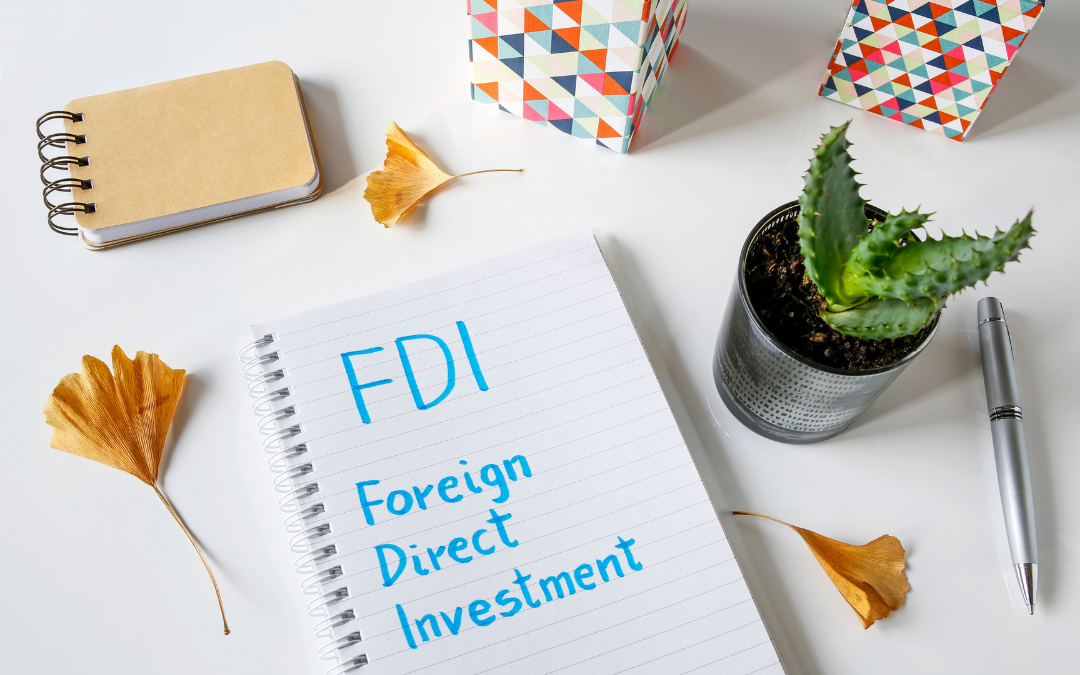Article by Faris Hasan from Economics Wing, GAEE JMI
India drew a total FDI inflow of 6.24 Billion during April 2021
According to the official statement by the Centre, measures taken by the Government on the fronts of the FDI policy reforms, ease of doing business, investment facilitation have resulted in the increased FDI inflows in India.
The growth in the country’s Foreign Direct Investment (FDI) is an endorsement of its status as a preferred investment destination among global investors.
What is foreign direct investment?
When a company invests in another company in a foreign land, the investment is said to be a foreign direct investment (FDI).

Types of FDI:
1) Horizontal FDI: In this, an investor would primarily invest in a business along similar industry lines as that of the business originally owned /operated by the investor.
For example, a British-based company, XYZ, may invest in or purchase the Indian company ABC, which also produces similar products as XYZ does. Since both the companies belong to the same industry of merchandise and apparel, the FDI is classified as horizontal FDI.
2) Vertical FDI: Here, an investor would invest in a supply chain that may or may not be along the FDI investor’s industry lines.
Vertical FDIs are further categorised as backward vertical integrations and forward vertical integrations. For instance, the Swiss Coffee producer Nescafe may invest in coffee plantations in Brazil, Columbia, Vietnam, etc. Since the investing firm purchases a supplier in the supply chain, this type of FDI is known as backward vertical integration. Conversely, forward vertical integration occurs when a company invests in another foreign company that is ranked higher in the supply chain; for instance, a coffee company in India may wish to invest in a French grocery brand.
3) Conglomerate FDI: When investments are made in two completely different companies of entirely different industries, the transaction is known as conglomerate FDI. For instance, An American company, ABC, maybe into the retail business it may invest in the Indian XYZ company, which manufactures electrical appliances. This is called a Conglomerate FDI.
4) Platform FDI: The last type of foreign direct investment is platform FDI. In platform FDI, a business expands into a foreign country, but manufactured products are exported to another third country. For instance, the French perfume brand Chanel set up a manufacturing plant in the USA and exported products to other countries in America, Asia, and Europe.
FDI benefits India in many ways:
Increased Employment and Economic Growth
Increased FDI boosts the manufacturing as well as the services sector. This creates jobs and helps reduce unemployment among the educated youth and skilled and unskilled labour in the country.
Human Resource Development
Human Capital refers to the knowledge and competence of the workforce. Skills gained and enhanced through training and experience boost the education and human capital quotient of the country.
Development of Backward Areas
FDI enables the transformation of backward areas in a country into industrial centres. This provides a boost to the social economy of the area.
Provision of Finance & Technology
Recipient businesses get access to the latest financing tools, technologies and operational practices from across the world. Over time, the introduction of newer, enhanced technologies and processes results in their diffusion into the local economy, resulting in enhanced efficiency and effectiveness of the industry.
Improved Capital Flow
The inflow of capital is particularly beneficial for countries with limited domestic resources and nations with limited opportunities to raise funds in global capital markets.
Creation of a Competitive Market
A healthy competitive environment pushes firms to enhance their processes and product offerings continuously, thereby fostering innovation. Consumers also gain access to a wider range of competitively priced products.
How does India get FDI?
After getting to know a little about what FDIs are, we can conclude that they are a great source of economic development. For India, FDIs usually arrive via some routes. A few of the common ones are:
Automatic Route:
The investor does not require approval from the Reserve Bank of India or the Government in this route.
Government Route:
You guessed it! This route requires approval from the Government of India. Sectors that come under the ‘up to 100% Government Route’ category are:
- Banking & Public sector: 20%
- Broadcasting Content Services: 49%
- Core Investment Company: 100%
- Food Products Retail Trading: 100%
- Mining & Minerals separations of titanium bearing minerals and ores: 100%
- Multi-Brand Retail Trading: 51%
- Print Media (publications/ printing of scientific and technical magazines/specialty journals/periodicals and facsimile edition of foreign newspapers): 100%
That being said, there are still a few industries in which FDI is strictly prohibited via any route. Some of these industries are:
- Atomic Energy Generation
- Any Gambling or Betting businesses
- Lotteries (online, private, government, etc.)
- Investment in Chit Funds
- Tobacco or related product businesses etc.
(Faris Hasan is a B.Tech. (Electronics and Communication Engineering) student at Jamia Millia Islamia, Delhi, and a part GAEE JMI, an autonomous branch of Global Association of Economics Education in India. The views expressed are personal and they do not purport to reflect the opinions or views of GAEE or its members.)
Follow Us & Stay Tuned: https://linktr.ee/gaee.jmi


Recent Comments